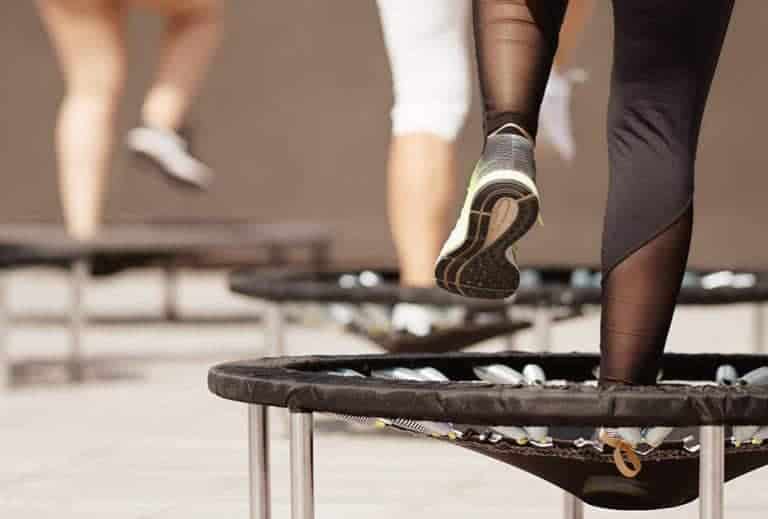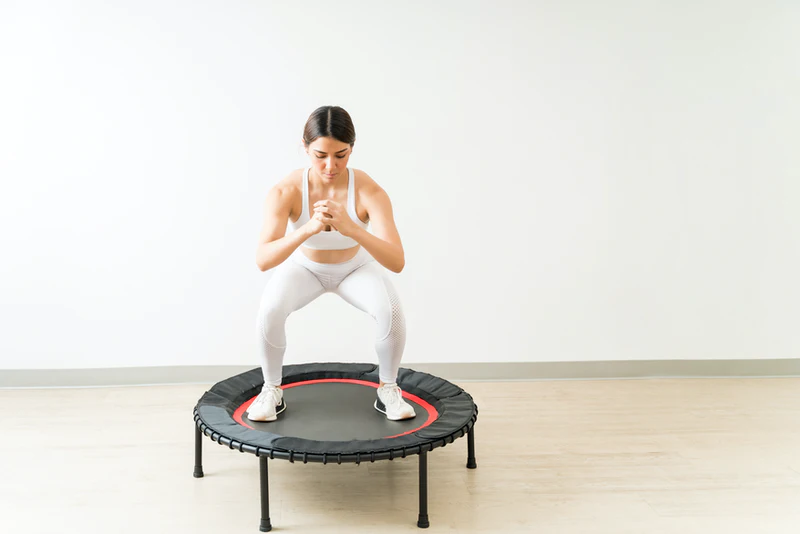How Does Rebounding Help With Balance?
Remember what a blast you used to have jumping on the trampoline as a kid?
You might not have known it then, but while you were working on your hang time, you were also strengthening your muscles, fortifying your bones, and enhancing your balance and overall coordination.
Ironically, these sorts of considerations become a much bigger deal as you start to get older—long after most people have taken their last bounce.
Rebounding is a popular exercise that offers a heap of benefits…
But how does rebounding help with balance? Rebounding helps with balance because every time you bounce the inner ear and cerebellum direct muscles to stabilise you. Bouncing on an unstable surface engages 638 muscles throughout the body to provide coordination to remain in a balanced position.
If you’re shopping around for the best rebounders, check out our comparison article.
Here is my recommendation for a sturdy rebounder that will accelerate your balance with its durable bungee springs:
- ✅Feel Better and Change your Body Shape – Scientists have proven that when using a quality mini trampoline, the continuous upward and free fall phase of jumping releases feel good endorphins which are so important for our mental health. The Maximus Pro Bungee Rebounder has twice as many bungee connectors than other indoor trampolines giving you an incredible well-being experience!
- ✅Free Workout Membership -Lose Weight and achieve your Fitness Goals with our 3 Beginners workouts on DVD plus free access to 100s of stimulating and motivating online Rebound Workouts & Exercise Workouts 24/7. They are all very low impact so no strain on your joints! The new Maximus Pro Bungee Trampoline is for adults and children (under supervision).
- ✅Experience a Silent Soft Landing on a Rebounder Built to Last Our non-folding pro rebounder is extremely robust. It has been tested up to 150kg body weight and has 60 strong connectors which are perfectly tensioned. This makes it the strongest bungee mini trampoline on the market for health & fitness training as well as being very kind on your joints. The Silent bounce means you can bounce anywhere, anytime
Last update on 2024-07-26 / Affiliate links / Images from Amazon Product Advertising API
Let’s look into how rebounding helps with balance.
Does Rebounding Improve Balance?
Of the myriad benefits offered by rebounding, balance ranks near the top of the list.
For those of you who aren’t yet familiar, rebounding is a fun and effective form of exercise centered around a special type of mini trampoline known as a “rebounder.”
Rebounders are much sturdier than ordinary trampolines since they’re designed specifically to bear the weight of fully-grown adults, who might be doing hundreds of bounces per workout.
Don’t make the mistake of thinking that rebounding is just jumping, though.
There’s virtually no limit to the things you can do on a rebounder, from performing balance drills to holding yoga poses to lifting weights (carefully, of course). They’re a lot like the stability balls you might find at your local gym, only infinitely more versatile and with a surer feel underfoot.
How Does Rebounding Help with Balance?
Just like ordinary trampolines, rebounders are topped with tautly-stretched nylon or polypropylene platforms making them last longer.
Simply standing on such unstable surfaces requires you to activate and coordinate nearly every muscle in your lower body, including stabilizer muscles that don’t get much use when you’re standing or walking on flat ground.
Once you start moving, you instantly involve the complex, interrelated musculature of the hips, abdomen, and mid and lower back—all of which play a crucial role in establishing and maintaining balance. Some rebounders are built with a stability bar to help you get used to the uneven surface, but this isn’t essential.
But balance is about more than just organized muscular effort. Rebounding also engages your brain and related processing centers, particularly the sensitive fluid-filled inner ear, which acts as a kind of internal gyroscope that helps promote poise and equilibrium.
Putting your inner ear through its paces prompts it to respond rapidly and precisely to keep you steady. This fine-tuning effect can pay dividends once you have both feet back on solid ground.
Rebounding Workouts for Improved Balance
Every year roughly 3 million seniors end up in the emergency room due to falls. One out of five of these falls results in serious injuries such as fractures or broken bones. By doing some simple rebounding exercises specifically for balance, individuals can decrease their risk of falls.
Beginner’s Balance Routine
To begin with the basic balance workout you’ll want to stand with your body straight, and place your feet just a couple of inches apart. Be sure to find a stable footing before starting the routine.
Once you’re comfortable, continue with the following steps:
- Place your palms together and lift your arms above your head.
- Slowly raise your right foot until it hovers a couple of inches above the ground. Begin by aiming for a five-second hold, and increase this every workout.
- Bring your right foot back to the surface.
- Continue the workout by repeating the same steps with the opposite leg.
Once you’ve repeated the exercise with both legs, you’ve completed one rep. Try aiming for two to four reps per session, but remember to start off slowly. If you’re only able to do one rep your first time, it’s ok. You can try to do more in your next session.

Advanced Rebounding Balance Routine
Once you’ve mastered the basic balance workout, you can move on to the advanced workout. If you own a handlebar, you can utilize it during this exercise by placing it to your left.
- Begin by placing your feet a few inches apart.
- Extend your arms in front of you so that they’re pointing straight ahead.
- Next, slowly raise your right leg and extend it until it is pointed straight in front of you.
- Gradually bend your left knee. If needed, use your handle for support.
- Hold this pose. Remember to start off slowly, holding it for just as long as you feel comfortable with. You can always increase the time in increments during each session.
- Lower your leg, and rotate your body so that the handle is now on your right.
- Repeat the steps with your opposite leg.
One rep is complete once you’ve lowered both legs. Aim for a couple of reps, slowly increasing to five as you become more comfortable.
How to Improve Balance with a Rebounder
If bettering your balance is your goal, your most productive approach will be to train a wide variety of movements that test your coordination, stability, and equilibrium.
You don’t even need to be jumping to reap the benefits of a rebounder’s ever-shifting platform. Standing alone is enough to begin sharpening your balance right away.

You can even practice holding different positions on your mini trampoline while you check your email, watch TV, or listen to your favorite podcast.
When you’re ready to take things to the next level, here are just a few things you can do to get more out of your rebounder regimen:
- Adopt a staggered stance or stand on one foot for as long as you can
- Perch on your tip-toes and lean softly from side to side
- March or jog in place
- Hold yoga poses that require your whole body to work as a unit (i.e., Chair Pose, Tree Pose, Forward Fold, Half Moon, etc.)
- Rep out bodyweight exercises like squats, lunges, calf raises, and V-ups
- Focus on staying securely rooted as you lift light weights
- Execute jumping jacks, high-knees, or tuck jumps for a more intense workout
You can even throw in additional balance work after your rebounder using a Bosu Ball to help improve your overall balance:
If you want to challenge yourself even more as you’re doing any of these, close your eyes. Vision is another important component of balance. When you remove it from the equation, your other faculties will be forced to compensate. Not only will your balance improve on a rebounder but your eyesight can also improve.
Conclusion
Does a mini trampoline help with balance? The answer is a clear and definite “yes.” In fact, few pieces of fitness equipment are as good for promoting balance as the rebounder.
It offers just the right amount of adaptation-inducing instability while also making it possible to perform any number of scalable movements and exercises. Anyone can hop on a rebounder, have a great workout or PT session, and walk away stronger than they were before.
By making regular use of one of these invaluable exercise aids, your balance will quite literally improve by leaps and bounds.
An ex-triathlete, fitness coach and writer with a Masters in Sports Physiology. Fitness is my passion and I've had my fair share of home fitness equipment tried and tested!





4 Comments